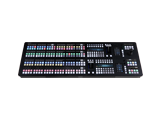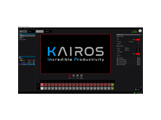Case Studies: Faculty of Informatics, Kansai University
Introducing a next-generation studio built by a Japanese university with KAIROS, a highly flexible video-production platform, to bring students' ideas to life.

― Mr. Kaihei Hase, Associate Professor Faculty of Informatics, Kansai University
Challenge
- Find a switcher that allows students to freely produce videos based on their own ideas.
Solution
- A highly flexible production environment was developed using the IT/IP platform "KAIROS", which offers as many layers as the GPU, the capacity of the system, allows with no restriction on the number of MEs or keys, unlike conventional switchers.
Background
Newly Renovated Studio for Learning Visual-expression Techniques
Kansai University's Faculty of Informatics teaches informatics through the systematic study of media information, social information systems, and computing. All students have access to the school's new video-production training studio and control system, which is similar to that of a television station. The facility was fully renovated in 2023 to keep up with the latest and most advanced technologies. This included the introduction of Panasonic's IT/IP platform "KAIROS", a next-generation switcher that is fully capable of accommodating today's rapidly evolving and diversifying content production.
Why KAIROS?
Intuitive Operation Gives Shape to New Ideas
When selecting its new switcher, Kansai University required not only 4K compatibility, but also a stable system that could be used by many students at the same time. In addition, the KAIROS platform's IP compatibility and ease of use were highly valued. Associate Professor Hase of the Faculty of Informatics said: "We chose KAIROS to replace our conventional switcher because understanding IP systems will be essential in the future. Another important factor in our decision was the highly intuitive nature of KAIROS, which can be easily operated by all students, even those who are new to the system. Since the platform is so easy to learn, we expect students to use it extensively to express their ideas through video."
Benefits
Switcher Helps Students Express Their Ideas Through Video
Commenting on the many benefits of introducing KAIROS, Mr. Hase said: "It would be very unfortunate if some students could not implement their unique video messages due to limitations on the switcher side, such as those faced with conventional switchers. KAIROS, on the other hand, allows unlimited layers, so students can freely experiment with different ideas, which I hope will encourage them to be more creative. Orangepao's Mr. Matsumoto, who maintains the studio and provides technical support to the students, said, "The control panel with freely assignable keys has a default layout that is easy to learn, even for beginners. It's impressive that the key layout can be changed to suit each student's level of proficiency."

KAIROS' control panel (center of switcher table) and two multi-viewers (on monitor shelf) can be customized to fit any layout.

Control panel with freely assignable keys offers a layout that is highly intuitive, even for first-time users.

The space-saving "Kairos Core 1000" mainframe can be stored in a compact, soundproof rack.
Promising Potential of KAIROS' Many Functions
KAIROS is equipped with the Canvas function, which allows users to freely produce and output videos in irregular screen aspects, such as 32:9 wide and portrait, not just 16:9. According to Mr. Hase: "One of the unique ways to use KAIROS is to create horizontal content by connecting multiple projectors together. We also have a projection-mapping class at our school, so we can expect to use it for that purpose as well." Mr. Matsumoto added: "KAIROS is compatible with NDI, SRT and ST 2110, so it can handle diverse video and audio formats from external sources over a network. We are looking forward to developing ideas for operations beyond those of conventional studios, such as remote live production for on- and off-campus events and university sporting events."

Students working with Kairos Creator GUI software, which has been well received for its intuitive layering and easy operation with a mouse.

Kairos Creator allows users to freely zoom in/out and move/rotate layers, just like with Microsoft® PowerPoint®.

Studio for capturing videos, which KAIROS then switches for recording and transmission.
In the Customer's Own Words
Generating New Ideas with KAIROS
"Unlike in the past, if you become a professional who specializes in one system, you will not be able to find a job for life," said Associate Professor Hase. "We are creating an environment that does not discourage students from continuing to learn about the equipment. Most importantly, they need to learn how to develop unique ideas and then both implement and communicate those ideas, but without being sidetracked by the highly technical demands of emerging new equipment. In this sense, I believe that the flexibility of KAIROS will stimulate students' imaginations and inspire them to continue learning. I would love to see our students discover new ways to use KAIROS on their own, rather than wait for faculty members to teach them."

Mr. Kaihei Hase
Associate Professor
Faculty of Informatics, Kansai University

Mr. Taro Matsumoto
Chief, Production Engineering Division
Orangepao
Note: Job titles at time of implementation
Fostering Expertise for an Advanced Digital Society
Kansai University's Faculty of Informatics was established in 1994 to cultivate experts capable of pioneering the next generation, using an integrated humanities-and-sciences approach to education and research focused on both information and information-related subjects. The faculty has evolved with the advancement of information technology in order to equip students with the expertise and practical skills needed to use data from a broad perspective to solve problems in the modern world.

Takatsuki Campus, home to the Faculty of Informatics
Equipment Installed
Location






